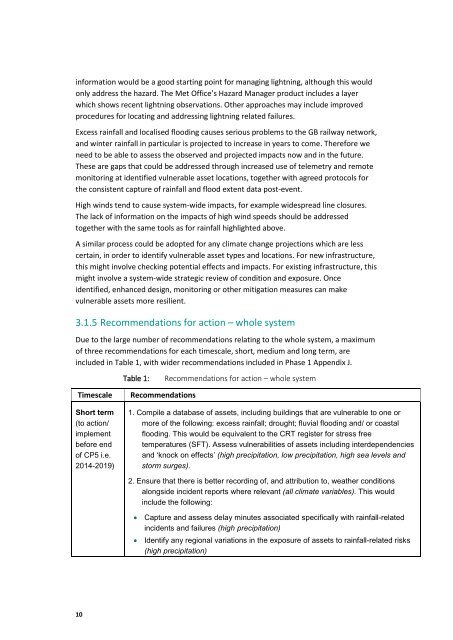Tomorrow's Railway and Climate Change Adaptation Final Report
2016-05-T1009-final-report
2016-05-T1009-final-report
You also want an ePaper? Increase the reach of your titles
YUMPU automatically turns print PDFs into web optimized ePapers that Google loves.
information would be a good starting point for managing lightning, although this would<br />
only address the hazard. The Met Office’s Hazard Manager product includes a layer<br />
which shows recent lightning observations. Other approaches may include improved<br />
procedures for locating <strong>and</strong> addressing lightning related failures.<br />
Excess rainfall <strong>and</strong> localised flooding causes serious problems to the GB railway network,<br />
<strong>and</strong> winter rainfall in particular is projected to increase in years to come. Therefore we<br />
need to be able to assess the observed <strong>and</strong> projected impacts now <strong>and</strong> in the future.<br />
These are gaps that could be addressed through increased use of telemetry <strong>and</strong> remote<br />
monitoring at identified vulnerable asset locations, together with agreed protocols for<br />
the consistent capture of rainfall <strong>and</strong> flood extent data post-event.<br />
High winds tend to cause system-wide impacts, for example widespread line closures.<br />
The lack of information on the impacts of high wind speeds should be addressed<br />
together with the same tools as for rainfall highlighted above.<br />
A similar process could be adopted for any climate change projections which are less<br />
certain, in order to identify vulnerable asset types <strong>and</strong> locations. For new infrastructure,<br />
this might involve checking potential effects <strong>and</strong> impacts. For existing infrastructure, this<br />
might involve a system-wide strategic review of condition <strong>and</strong> exposure. Once<br />
identified, enhanced design, monitoring or other mitigation measures can make<br />
vulnerable assets more resilient.<br />
3.1.5 Recommendations for action – whole system<br />
Due to the large number of recommendations relating to the whole system, a maximum<br />
of three recommendations for each timescale, short, medium <strong>and</strong> long term, are<br />
included in Table 1, with wider recommendations included in Phase 1 Appendix J.<br />
Table 1:<br />
Recommendations for action – whole system<br />
Timescale<br />
Short term<br />
(to action/<br />
implement<br />
before end<br />
of CP5 i.e.<br />
2014-2019)<br />
Recommendations<br />
1. Compile a database of assets, including buildings that are vulnerable to one or<br />
more of the following: excess rainfall; drought; fluvial flooding <strong>and</strong>/ or coastal<br />
flooding. This would be equivalent to the CRT register for stress free<br />
temperatures (SFT). Assess vulnerabilities of assets including interdependencies<br />
<strong>and</strong> ‘knock on effects’ (high precipitation, low precipitation, high sea levels <strong>and</strong><br />
storm surges).<br />
2. Ensure that there is better recording of, <strong>and</strong> attribution to, weather conditions<br />
alongside incident reports where relevant (all climate variables). This would<br />
include the following:<br />
• Capture <strong>and</strong> assess delay minutes associated specifically with rainfall-related<br />
incidents <strong>and</strong> failures (high precipitation)<br />
• Identify any regional variations in the exposure of assets to rainfall-related risks<br />
(high precipitation)<br />
10


